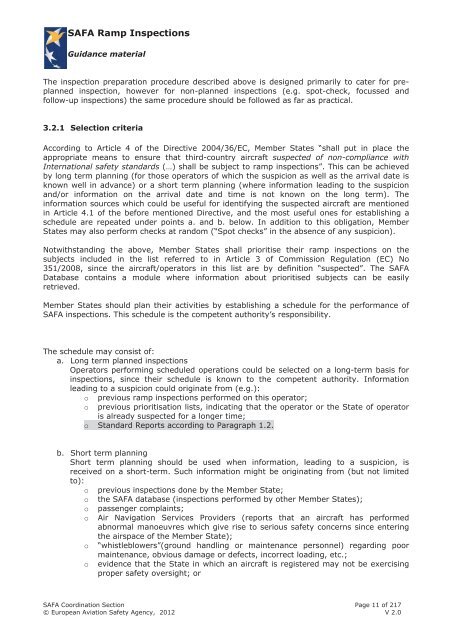SAFA Ramp Inspections - Code7700
SAFA Ramp Inspections - Code7700
SAFA Ramp Inspections - Code7700
You also want an ePaper? Increase the reach of your titles
YUMPU automatically turns print PDFs into web optimized ePapers that Google loves.
<strong>SAFA</strong> <strong>Ramp</strong> <strong>Inspections</strong>Guidance materialThe inspection preparation procedure described above is designed primarily to cater for preplannedinspection, however for non-planned inspections (e.g. spot-check, focussed andfollow-up inspections) the same procedure should be followed as far as practical.3.2.1 Selection criteriaAccording to Article 4 of the Directive 2004/36/EC, Member States “shall put in place theappropriate means to ensure that third-country aircraft suspected of non-compliance withInternational safety standards (…) shall be subject to ramp inspections”. This can be achievedby long term planning (for those operators of which the suspicion as well as the arrival date isknown well in advance) or a short term planning (where information leading to the suspicionand/or information on the arrival date and time is not known on the long term). Theinformation sources which could be useful for identifying the suspected aircraft are mentionedin Article 4.1 of the before mentioned Directive, and the most useful ones for establishing aschedule are repeated under points a. and b. below. In addition to this obligation, MemberStates may also perform checks at random (“Spot checks” in the absence of any suspicion).Notwithstanding the above, Member States shall prioritise their ramp inspections on thesubjects included in the list referred to in Article 3 of Commission Regulation (EC) No351/2008, since the aircraft/operators in this list are by definition “suspected”. The <strong>SAFA</strong>Database contains a module where information about prioritised subjects can be easilyretrieved.Member States should plan their activities by establishing a schedule for the performance of<strong>SAFA</strong> inspections. This schedule is the competent authority’s responsibility.The schedule may consist of:a. Long term planned inspectionsOperators performing scheduled operations could be selected on a long-term basis forinspections, since their schedule is known to the competent authority. Informationleading to a suspicion could originate from (e.g.):o previous ramp inspections performed on this operator;o previous prioritisation lists, indicating that the operator or the State of operatoris already suspected for a longer time;o Standard Reports according to Paragraph 1.2.b. Short term planningShort term planning should be used when information, leading to a suspicion, isreceived on a short-term. Such information might be originating from (but not limitedto):o previous inspections done by the Member State;o the <strong>SAFA</strong> database (inspections performed by other Member States);oooopassenger complaints;Air Navigation Services Providers (reports that an aircraft has performedabnormal manoeuvres which give rise to serious safety concerns since enteringthe airspace of the Member State);“whistleblowers”(ground handling or maintenance personnel) regarding poormaintenance, obvious damage or defects, incorrect loading, etc.;evidence that the State in which an aircraft is registered may not be exercisingproper safety oversight; or<strong>SAFA</strong> Coordination Section Page 11 of 217© European Aviation Safety Agency, 2012 V 2.0
















